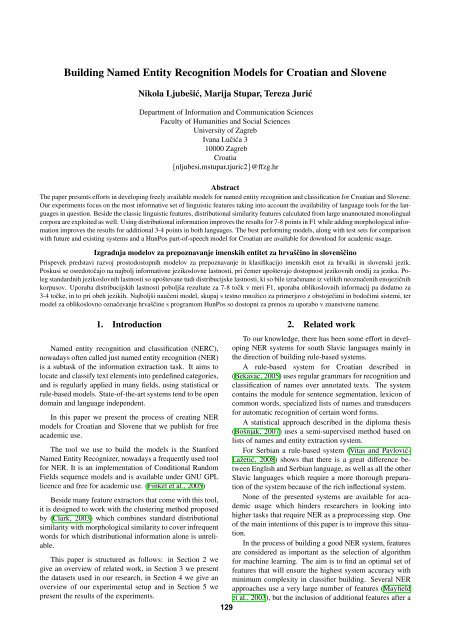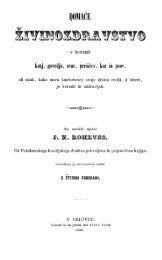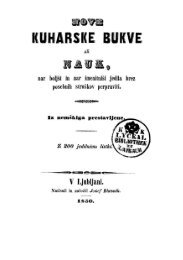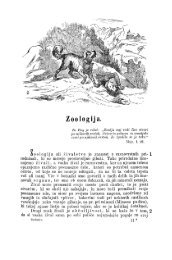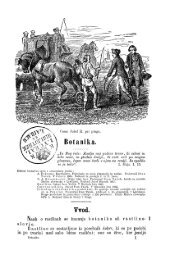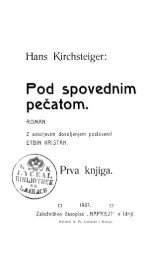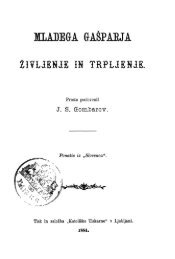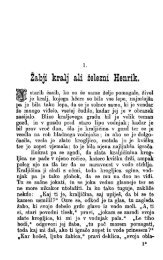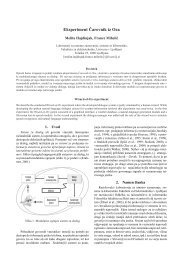Proceedings - Natural Language Server - IJS
Proceedings - Natural Language Server - IJS
Proceedings - Natural Language Server - IJS
Create successful ePaper yourself
Turn your PDF publications into a flip-book with our unique Google optimized e-Paper software.
Building Named Entity Recognition Models for Croatian and Slovene<br />
Nikola Ljubeˇsić, Marija Stupar, Tereza Jurić<br />
Department of Information and Communication Sciences<br />
Faculty of Humanities and Social Sciences<br />
University of Zagreb<br />
Ivana Lučića 3<br />
10000 Zagreb<br />
Croatia<br />
{nljubesi,mstupar,tjuric2}@ffzg.hr<br />
Abstract<br />
The paper presents efforts in developing freely available models for named entity recognition and classification for Croatian and Slovene.<br />
Our experiments focus on the most informative set of linguistic features taking into account the availability of language tools for the languages<br />
in question. Beside the classic linguistic features, distributional similarity features calculated from large unannotated monolingual<br />
corpora are exploited as well. Using distributional information improves the results for 7-8 points in F1 while adding morphological information<br />
improves the results for additional 3-4 points in both languages. The best performing models, along with test sets for comparison<br />
with future and existing systems and a HunPos part-of-speech model for Croatian are available for download for academic usage.<br />
Izgradnja modelov za prepoznavanje imenskih entitet za hrvaˇsčino in slovenˇsčino<br />
Prispevek predstavi razvoj prostodostopnih modelov za prepoznavanje in klasifikacijo imenskih enot za hrvaˇski in slovenski jezik.<br />
Poskusi se osredotočajo na najbolj informativne jezikoslovne lastnosti, pri čemer upoˇstevajo dostopnost jezikovnih orodij za jezika. Poleg<br />
standardnih jezikoslovnih lastnosti so upoˇstevane tudi distribucijske lastnosti, ki so bile izračunane iz velikih neoznačenih enojezičnih<br />
korpusov. Uporaba distribucijskih lastnosti poboljˇsa rezultate za 7-8 točk v meri F1, uporaba oblikoslovnih informacij pa dodatno za<br />
3-4 točke, in to pri obeh jezikih. Najboljˇsi naučeni model, skupaj s testno mnoˇzico za primerjavo z obstoječimi in bodočimi sistemi, ter<br />
model za oblikoslovno označevanje hrvaˇsčine s programom HunPos so dostopni za prenos za uporabo v znanstvene namene.<br />
1. Introduction<br />
Named entity recognition and classification (NERC),<br />
nowadays often called just named entity recognition (NER)<br />
is a subtask of the information extraction task. It aims to<br />
locate and classify text elements into predefined categories,<br />
and is regularly applied in many fields, using statistical or<br />
rule-based models. State-of-the-art systems tend to be open<br />
domain and language independent.<br />
In this paper we present the process of creating NER<br />
models for Croatian and Slovene that we publish for free<br />
academic use.<br />
The tool we use to build the models is the Stanford<br />
Named Entity Recognizer, nowadays a frequently used tool<br />
for NER. It is an implementation of Conditional Random<br />
Fields sequence models and is available under GNU GPL<br />
licence and free for academic use. (Finkel et al., 2005)<br />
Beside many feature extractors that come with this tool,<br />
it is designed to work with the clustering method proposed<br />
by (Clark, 2003) which combines standard distributional<br />
similarity with morphological similarity to cover infrequent<br />
words for which distributional information alone is unreliable.<br />
This paper is structured as follows: in Section 2 we<br />
give an overview of related work, in Section 3 we present<br />
the datasets used in our research, in Section 4 we give an<br />
overview of our experimental setup and in Section 5 we<br />
present the results of the experiments.<br />
2. Related work<br />
To our knowledge, there has been some effort in developing<br />
NER systems for south Slavic languages mainly in<br />
the direction of building rule-based systems.<br />
A rule-based system for Croatian described in<br />
(Bekavac, 2005) uses regular grammars for recognition and<br />
classification of names over annotated texts. The system<br />
contains the module for sentence segmentation, lexicon of<br />
common words, specialized lists of names and transducers<br />
for automatic recognition of certain word forms.<br />
A statistical approach described in the diploma thesis<br />
(Boˇsnjak, 2007) uses a semi-supervised method based on<br />
lists of names and entity extraction system.<br />
For Serbian a rule-based system (Vitas and Pavlović-<br />
Laˇzetić, 2008) shows that there is a great difference between<br />
English and Serbian language, as well as all the other<br />
Slavic languages which require a more thorough preparation<br />
of the system because of the rich inflectional system.<br />
None of the presented systems are available for academic<br />
usage which hinders researchers in looking into<br />
higher tasks that require NER as a preprocessing step. One<br />
of the main intentions of this paper is to improve this situation.<br />
In the process of building a good NER system, features<br />
are considered as important as the selection of algorithm<br />
for machine learning. The aim is to find an optimal set of<br />
features that will ensure the highest system accuracy with<br />
minimum complexity in classifier building. Several NER<br />
approaches use a very large number of features (Mayfield<br />
et al., 2003), but the inclusion of additional features after a<br />
129


